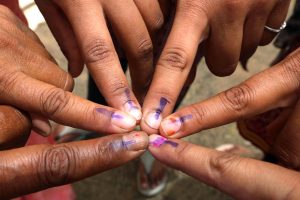In honour of Maa Durga, who resides within each woman and celebrates her days with us, we bring forth the story of Bijoli Murmu, a self-taught toto-driver from an indigenous community of Salboni in Midnapore.
Bijoli, as she describes, was brought up in a poverty stricken household where her parents arranged her marriage in the hopes that she would have a better life.
Her initial move for freedom was her urge to perform and be a part of an indigenous traditional dance group. Despite societal prejudices and norms, she persisted in going forth with her dream until fear of judgement and segregation caused the group to gradually disband. However, destiny aligned with her efforts to break free from the chains of subjugation, thus guiding her towards liberation.
It was in 2016, her husband’s legs were fractured in an industrial accident, leaving him unable to work for two years. This unplanned occurrence left the family with no active earning member, thus pushing them towards severe financial hardships, making it challenging to provide food for the whole family and education for their two sons.
Without several windows of opportunities, he was compelled to seek out alternative sources of income. Notwithstanding the prevailing societal conventions, she identified the transportation issue needed within her village and introduced an electric rickshaw, commonly known as a ‘toto’. Based upon the symbolic gesture of immortality, she named her beloved toto as ‘Phoenix’, representing her resolute spirit that rises stronger and more triumphant after each setback.
“Toto-driver, is a profession that was underserved for the women in our community. I met with resistance not only from the general public but also from my immediate family. Relatives were quick to criticise my choice. However, I understood that no one would extend financial assistance to alleviate our struggles. Therefore, I resolved to disregard their opinions and pursue a socially beneficial and honourable profession to earn a living”, says Bijoli.
Breaking financial barriers, she became the first woman to purchase and drive a toto, taking a loan of 3 lakh rupees. Initially her village had only two or three totos, and the drivers of those totos were all male. This made transportation for females more challenging, especially after dusk. She then decided to teach herself to drive in order to save the driving tuition fees of Rs 600 amid all the financial thrusts.
“After the first few hours I brought the vehicle, I requested the sellers to drive me to some distance so that I could observe and learn and consider it as a driving lesson. They happily agreed. Hence, one of them drove the vehicle for approximately 4 to 5 kilometres, while I sat beside him, paying close attention and making every effort to learn and for then I managed to come home driving alone. Subsequently, over the course of two to three days, I took the toto to a nearby football ground, where I practised driving for numerous hours”, says Bijoli.
Drawn by the rare and unusual sight of a woman driving a public transportation vehicle, in a remote village area, in a domain traditionally dominated by men, Antara Bannerjee, an individual working for a private organisation in the village of Salboni, took her interest and invited two other individuals for extensive research.
“We started observing Bijoli Di in 2022. After carefully observing her and going through research for over two years, we started shooting the film. The entire village and local people from Salboni came forward in all possible ways to support the team and got associated with the shooting process”, says Antara.
After two years of careful observation and research, Banerjee formed a team with Saurav Mookherji and Purba Chakraborty to create a film documenting Bijoli Di’s life, titled, It has a Life. Purba, a food researcher, is here, responsible for the research of the community while also handling the subtitling of films. While Saurav is responsible for filming and cinematography.
The film has been crafted with basic tools that they had on board, to be specific, a Nikon D5300 with a lens of 18.55mm as the zoom lens and 30 mm as the prime lens with a tripod. Describing the cinematography, Saurav explains, “As an independent filmmaker, I’ve navigated the intricate pathways of storytelling, striving to instil purpose and meaning into every frame. Here I have tried to adhere with the guerrilla technique of filmmaking, which I have been doing with all my previous projects”.
He adds, “However, I must say that independent filmmaking is suffering if you consider the budget, the locations and the technical support. It has been hard for me as an independent filmmaker to implement advanced technologies where the entire filmmaking was impromptu. We have dealt with the enormous challenges, which include the incorporation of natural lights, unprecedented climatic occurrences and insufficiency of helping hands on ground. Despite the challenges, I have poured my heart and soul into each project, aiming to create narratives that resonate deeply with audiences and spark conversations that matter”.
To gain insights and perspectives of the individual whose life is depicted in the film documentary, The Statesman delved into a deeper level and conversed with her over the phone, in which she brought our attention to the challenges as a female toto-driver. She narrates one of the incidents where, in her initial phase, when she drove off with the toto, some middle-aged boys ran after her while she was driving off, loudly saying, “See! A lady-driver!”, making her feel unusual and awkward. She says, “It was obvious because back then, in such an atmosphere, seeing a woman driving a vehicle was quite uncommon. Yet, I am proud of my family and husband, who supported me through and through this journey”.
Her challenges didn’t end there. At times, in dawn, early in the morning or late at night, when she went to pick up her customers from the train station, it has been recorded that she faced several unpleasant and illicit touches and did get uncomfortable with the behaviour from some of them, namely the male passengers. They would not ask for their favours outright, but would sit in ways to make her feel uneasy and would try to touch her improperly. One of them even offered to have her physically for one night in exchange for payment. She then reported the event to the police, for which the criminal was even punished. She has always raised her voice on such intolerable occasions and sometimes even has cancelled the trip at the very point. She keeps a cane stick and a car repair tool handy with her to keep herself safe from the bad creepy male passengers, much like the wild animals.
In general, it is perceived that female passengers may feel a greater sense of security with female drivers, although this is not a universal experience. The Statesman asked the filmmakers if having female drivers involved in transportation would make every passenger feel more secure during their journeys or not, for which they said, “We think the below factors are responsible while we discuss this topic: individual preferences, driver training and behaviour, cultural factors, societal expectations and stereotypes, and safety measures taken during driving irrespective of time and distance. It’s important to focus on creating a safe and inclusive transportation environment for everyone, regardless of gender. However, if women start to step out at night, claiming their right to safe space and income equality, things will definitely change. There was a time when women were not allowed to go to school or pursue studies, but with women coming forward, claiming their right to education, things have changed and so have the narratives around it. We believe if more women drivers join the transportation sector and start navigating through late hours of the day, it will be difficult at the beginning, but things will change”.
Bijoli’s car repair tool serves not only as a safety precaution but also is used by her for its original and appropriate requirements. In a domain often dominated by men, Bijoli once again excels and breaks prejudices, demonstrating her capability in which the tool becomes a means to challenge gender stereotypes. Much like driving, she also honed her skills in vehicle maintenance through her observations, conversations, and lessons learned at repair shops. At present, if her vehicle faces minor issues on the midway, Bijoli confidently takes matters into her own hands, handling repairs herself until the problem escalates to a more significant level.
It proves that her buying and driving toto was the best decision she made, not only to break boundaries,but also to sustain her family in terms of food and education. When she initially brought the toto, her village had only 5–6 of them and hence there were not enough transportation services available for people. She, during her financially dreadful days, earned almost Rs 800 per say, and even Rs 1,200 at times. Gradually several of them, both men and women, saw and brought totos and now as the numbers increased, her income became a little down from Rs 200 to Rs 500 at maximum.
Nevertheless, her husband’s health improved after two consecutive years and he is back as a factory-worker. For now, she combines her toto driving with dance performances, diversifying her sources of income.
Her success motivated women from neighbouring villages to follow in her footsteps, leading to an increase in the number of women owning and driving totos.












